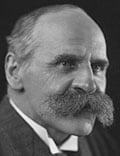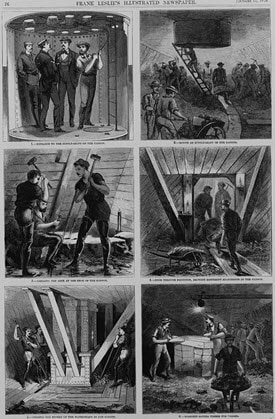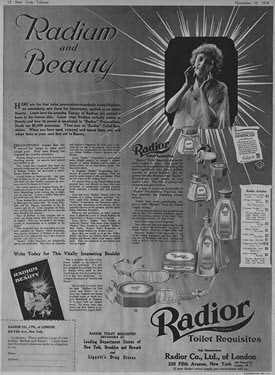Case reports are the low-hanging fruit in the orchard of medical publishing: easy papers to write, padding for the CV. But not always. Sometimes, these cases represent the earliest awareness of larger issues and lead to major changes in patient care and public health. Here we look at four such case reports over the past 150 years.
What Happened in Caissons Didn't Stay in Caissons
From 1869 to 1883, several thousand workers participated in the construction of the Brooklyn Bridge, connecting what were then the separate cities of New York and Brooklyn. Many of these men worked underwater within caissons — enormous, floorless chambers full of air that sunk gradually deeper into the floor of the East River as the workers excavated dirt from below.
After reaching bedrock or close to it, the two caissons, one on the New York side, the other on the Brooklyn side, would be filled with cement to become foundations for the two towers holding the bridge. On the way down, the air pressure in the chamber would rise to equal that of the surrounding water, exposing workers to increasingly hyperbaric conditions.
Several years earlier, caisson workers building the Eads Bridge over the Mississippi River at St. Louis, Missouri, fell ill.
Andrew H. Smith, a physician caring for the workers and advising the Roeblings, the engineering family building the Brooklyn Bridge, published some 110 cases of a condition that struck workers on that project upon ascending from the caissons.

John Scott Haldane
Calling the condition caisson disease, Smith was describing what we now call decompression sickness. The large number of cases and detailed descriptions in his reports led Scottish physiologist John Scott Haldane (the discoverer of the Haldane effect) to research the condition and teach the world about it. This effort led to a realization that symptoms, such as joint pains known as the bends; severe, sometimes fatal breathing disability known as the chokes; and neurologic deficits that in some cases, were fatal or left the victim paralyzed, triggered by nitrogen gas bubbling out of solution in body tissues.
The effects on the joints, respiration, and nervous system occurred when people breathing high-pressure air transferred to the lower-pressure environment of the water surface. This revelation, in turn, taught researchers quickly that controlled gradual ascent with stops to off-gas nitrogen could prevent the condition.
A Mendelian Genetic Disease
Bernard Sachs was a New York neurologist who had trained under a host of prominent European experts, including Rudolph Virchow, Adolf Kussmaul, and Jean-Martin Charcot. In 1887, Sachs published and presented a paper to the American Neurological Association describing cases of what he was calling amaurotic family idiocy. Occurring in young children that he'd seen since 1885 at Mount Sinai and other hospitals in New York City, Sachs described a condition marked by deteriorating cognition and poorly developed flagging motor function. In the course of a decline leading to death within a few years of birth, the children also suffered severe visual deficits — the result of the appearance of a cherry red spot on the macula. (We now know those spots stem from the accumulation in retinal ganglion cells of glycosphingolipids, which also build up throughout the central nervous system of patients with the disorder Sachs described.)
Unknown to Sachs at the time, a London ophthalmologist named Warren Tay had described the same set of symptoms and signs in 1881. Sachs, however, observed that the disease struck almost exclusively Ashkenazi Jews, whose population in New York City was beginning to surge in the latter decades of the 19th century. By the early 1900s, the association with Ashkenazi Jews led to the realization that Tay-Sachs disease was inherited with autosomal recessive genetics.
The disease thus became one of a handful of early examples of monogenetic (Mendelian) diseases that helped launch the science of medical genetics. In 1969, researchers Shintaro Okada and John S. O'Brien identified hexosaminidase A as the enzyme whose deficiency leads to the accumulation of glycosphingolipid in nerve cells. Over the past century, Tay-Sachs has also been identified as particularly common in French Canadians of eastern Quebec and certain other ethnic groups, and various single-gene mutations have been linked to the condition.
Occupational Poisoning of Radium Dial Painters
Marie Skłodowska-Curie and Pierre Curie announced the discovery of radium-226 in 1898 and found three more isotopes of the element over the next decade. Soon, the health-product industry began adding radium to elixirs and other products intended for application to the body, ingestion, and spa baths on the proposition that the glowing radiologic energy could energize the body in beneficial ways.
During World War I, the United States Radium Corporation (USRC) began using the element in paint to make military watches and instrument dials auto-illuminate.
More than 3000 women were employed in USRC factories, many of them in Orange, New Jersey. They were instructed to lick brushes before dipping them into the radium paint to keep the points fine to mark the dials. Considering radium exposure to be a job perk, these women would sometimes paint their teeth or faces to make them glow at night.
By the early 1920s, many former workers were suffering loss of teeth, deterioration of their jaws and other bones, and tumors that often turned cancerous. Upon challenging the company to investigate, some of the women were told that they suffered from syphilis. Survivors waited years to obtain compensation for their injuries, and many died before the money arrived. But publication of the various cases by Harrison Martland and colleagues in 1925 and 1929 would become watersheds, leading to understanding of the damaging effects of exposure to high-energy radioactive isotopes, especially alpha emitters like radium-226.
Malignant Hyperthermia
In 1960, a letter appeared in The Lancet describing the curious case of a young man with a compound tibial and fibular fracture who was scheduled for surgery to repair the injury under general anesthesia. The patient had an alarming family history: 10 of his relatives had died mysteriously after having received general anesthesia.
They all had received ether anesthesia or ethyl chloride, and he was given a new anesthetic, halothane; yet, his temperature rose by several degrees. He developed what we now know as malignant hyperthermia (MH), and he'd have died if not for quick administration of ice around his body. But he also had a good amount of luck, becoming the first documented case of MH to survive at a pivotal moment when medicine was just recognizing the condition.
Michael Denborough wrote The Lancet letter and was first author on the subsequent article in the British Journal of Anaesthesia. MH is a rare but life-threatening complication caused by inhalational anesthetics (certain inhalational agents more than others), the depolarizing neuromuscular blocker succinylcholine, and extreme heat from physical activity.
Initially, the latter was through to be a separate entity, but later, it was realized that the same process underlay both. Manifesting with extreme body heating related to widespread skeletal muscle activity, respiratory acidosis, and rhabdomyolysis with consequent disruptions of electrolytes, MH remains a significant concern for anesthesiologists. The condition is treated with dantroline and active cooling of the patient with ice baths and cold IV fluids. The rapidly expanding knowledge of molecular genetics has shed light on hereditary abnormalities of the ryanodine receptor located in the sarcoplasmic reticulum and is thought to be a key player in generating MH, but the understanding of the genetics of the condition has not reached the point as to predict accurately who is at risk.
Dr Warmflash's recent book, Moon: An Illustrated History: From Ancient Myths to the Colonies of Tomorrow, tells the story of the moon's role in a plethora of historical events, from the origin of life to early calendar systems, the emergence of science and technology, and the dawn of the Space Age.
Credits:
Lead image: Wikimedia Image 1: Library of Congress Image 2: Hulton Deutsch/Getty Images
Image 3: Wikimedia Commons
Image 4: Library of Congress
Image 5: Wikimedia
Medscape Internal Medicine © 2023
Cite this: Deadly Caissons, Toxic Watch Faces and More Medical Mysteries - Medscape - Mar 20, 2023.
















Comments